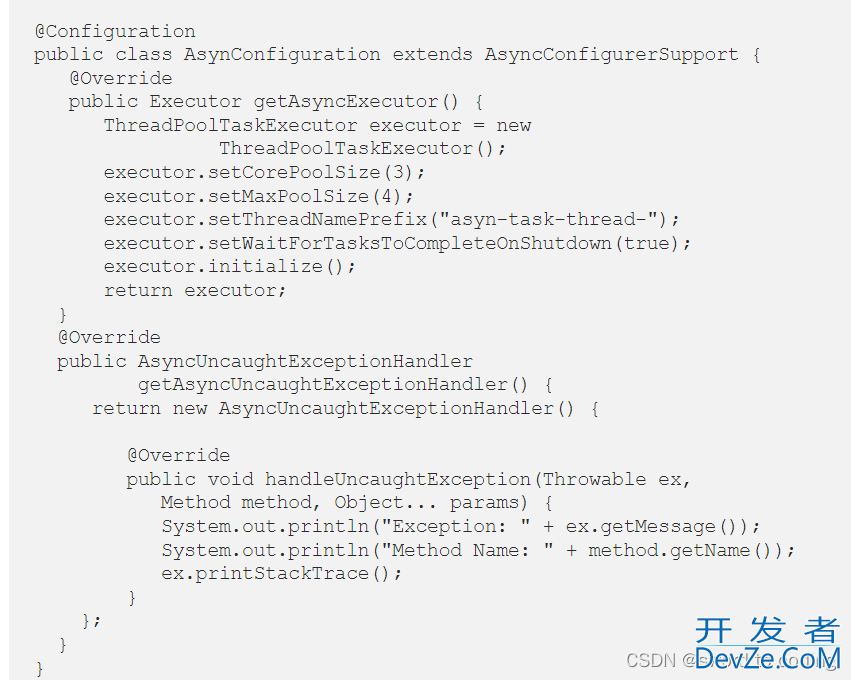springboot中如何使用@Async方法
目录
- 一.在启动类上加上 启动注解 @EnableAsync
- 二. 在需要进行异步处理的方法上加上注解@ Async
- 三.自定义异步采用的线程池
- 法一. 实现配置类 AsyncConfigurer
- 法二. 自定义一个线程池bean,在使用@Async注解时指定线程池
- 总结
一.在启动类上加上 启动注解 @EnableAsync

二. 在需要进行异步处理的方法上加上注解@ Asyncjavascript
注意事项:
注解的方法 必须是public方法,因为该注解采用的是动态代理的方式
无论该方法的返回值是什么,被@Async注解的方法必定是Null
在方法内不要递归调用,否则无效
三.自定义异UpWaVSHaaB步采用的线程池
当我们没有自定义时,springboot是怎么样采用默认配置的?

翻译:当spring执行这个方法时,默认会搜索关联的线程池定义。
上下文中唯一的 Spring 框架 TaskExecutor bean 或名为“taskExecutor”的 Executor bean。
如果这两个都不能解析,默认会使用sp编程客栈ring框架SimpleAsyncTaskExecutor来处理异步方法的执行。
使用上面的步骤,可以直接使用异步注解了,但是需要注android意的是,异步所需的线程池采用的是springboot框架默认的线程池,我们有时候还需要自定义线程池来限制并发线程数和最大队列。
怎么配置异步功能的异步线程池?
法一. 实现配置类 AsyncConfigurer
@Configuration
@EnableAsync
public class BaseAsyncConfigurer implements AsyncConfigurer {
@Override
public Executor getAsyncExecutor() {
ThreadPoolTaskExecutor executor = new ThreadPoolTaskExecutor();
//核心线程池数量,方法: 返回可用处理器的Java虚拟机的数量。
executor.setCorePoolSize(Runtime.getRuntime().availableProcessors());
//最大线程数量
executor.setMaxPoolSize(Runtime.getRuntime().availableProcessors()*5);
//线程池的队列容量
executor.setQueueCapacity(Runtime.getRuntime().availableProcessors()*2);
//线程名称的前缀
executor.setThreadNamePrefix("this-excutor-");
// setRejectedExecutionHandler:当pool已经达到max size的时候,如何处理新任务
// CallerRunsPolicy:不在新线程中执行任务,而是由调用者所在的线程来执行
//executor.setRejectedExecutionHandler(new ThreadPoolExecutor.CallerRunsPolicy());
executor.initialize();
return executor;
}
/*异步任务中异常处理*/
@Override
public AsyncUncaughtExceptionHandler getAsyncUncaughtExceptionHandler() {
return (Throwable ex, Method method, Object... params)->{
//todo 异步方法异常处理
System.out.println("class#method: " + method.getDeclaringClass().getName() + "#" + method.getName());
System.out.println("type : " + ex.getClass().getName());
System.out.println("exception : " + ex.getMessage());
};
}
}
实现了这个接口过后,在使用@Async时就会自动使用我们自定义的线程池getAsyncExecutor了。

法二. 自定义一个线程池bean,在使用@Async注解时指定线程池
@Bean("threadPoolTaskExecutor")
public TaskExecutor getAsyncExecutor() {
ThreadPoolTaskExecutor executor = new ThreadPoolTaskExecutor();
executor.setCorePoolSize(20);
executor.setMaxPoolSize(1000);
executor.setWaitForTasksToCompleteOnShutdown(true);
executor.setThreadNamePrefix("Async-");
return executor;
}
使用注解@Async(“threadPoolTaskExecutor”) ,相当于在一个项目中,不同方法上面的@Async可以使用不同的线程池
总结
一UpWaVSHaaB般情况下,建议手动实现AsyncConfigurer来自定义线程池。
如果某些方法需要使用其他的线程池,就使用bean添加一个线程池,并在@Async的value值进行指定线程池。
以上为个人经验,希望能给大家一个参考,也希望大家多多支持编程客栈(www.devze.com)。






 加载中,请稍侯......
加载中,请稍侯......
精彩评论